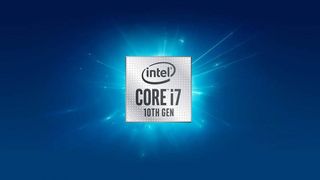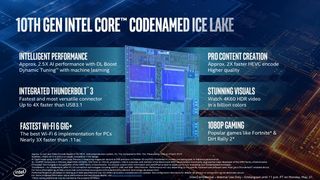Which Intel Ice Lake Processor is Right for You?
9th Gen? That’s so last month -- Intel recently unveiled its new 10th Gen processors. Designed specifically for laptops and 2-in-1s, the new 10 nanometer chips, codenamed “Ice Lake,” will offer a host of new features including artificial intelligence, better overall performance along with better connectivity with Thunderbolt 3 and Wi-Fi 6 support. And with new integrated graphics chips, Intel’s promising better graphics with improved rendering capabilities and 4K HDR.

But in addition to rolling out new chips, Intel is also rolling out new naming conventions. And with 11 new chips to consider, things can get a bit confusing. So to help keep things straight, here’s a guide to all the new Ice Lake chips in Intel’s lineup.
Stay tuned as we’ll be updating this page when the H Series CPUs launch.
Naming Convention
When looking at an Intel processor, the first thing you see is the brand modifier, which is most often i3, i5, i7 or i9. The first number after the hyphen is the generation indicator; so for Ice Lake chips, you’ll see a 10.
Unlike previous generations of Intel chips, these don’t end in their respective series letter. For that, you’ll need to check out the 4th number which designates the chip’s series. So 5 corresponds to U Series CPUs while 0 represents Y Series. The “8” in the Core i7-1068G7 seems to be an outlier, but rest assured it is a U Series processor.

At the end of the sequence, you’ll find a number/letter combination. Instead of calling out the series affiliation, these two characters refer to the integrated graphics card in the system and its graphics processing units. Keep this in mind since Intel is nixing numbers for its integrated GPUs. That means that Intel UHD 630 Graphics are out and Intel Iris Plus is in.
Stay in the know with Laptop Mag
Get our in-depth reviews, helpful tips, great deals, and the biggest news stories delivered to your inbox.
It’s confusing, I know, but stick with me. Going back to the final pair of characters, a processor number ending with G7 = 64 Graphics EUs in the Iris Plus GPU. The G4 callout equals 48 while a G1 means 32.
U Series
Featuring higher base clock speeds and (TDP) Thermal Design Power, which typically means speedier processing at the expense of higher heat temperatures and energy, U Series CPUs are the more powerful processors compared to Y series. Driving home this fact even further is that these chips are most often paired with Intel’s Iris Pro GPUs, which are Intel’s most powerful chips. You’ll typically find U Series CPUs in devices meant for everyday use.
| Processor | Cores/Threads | Graphics (EU) | Base Frequency | Max Single Core Turbo (GHz) | Max All Core Turbo (GHz) | Graphics Max Frequency (MHz) |
| Intel Core i7-1060G7 | 4/8 | 64 Intel Iris Plus | 2.3 | 4.1 | 3.6 | 1.10 |
| Intel Core i7-1065G7 | 4/8 | 64 Intel Iris Plus | 1.3 | 3.9 | 3.5 | 1.10 |
| Intel Core i5-1035G7 | 4/8 | 64 Intel Iris Plus | 1.2 | 3.7 | 3.3 | 1.05 |
| Intel Core i5-1035G4 | 4/8 | 48 Intel Iris Plus | 1.1 | 3.6 | 3.3 | 1.05 |
| Intel Core i5-1035G1 | 2/4 | 32 Intel UHD Graphics | 1.0 | 3.6 | 3.3 | 1.05 |
| Intel Core i3-1005G1 | 2/4 | 32 Intel UHD Graphics | 1.2 | 3.4 | 3.4 | 0.90 |
Y Series
Intel’s Y Series chips are typically at the bottom of the totem pole offering a fanless design. They’re great for light tasks such as web browsing and light productivity. The low TDP allows for the fanless design, which is perfect for ultra-slim laptops. And while Y Series laptops are prized for their long battery life, they typically can’t match the performance power of their U Series cousins.
| Processor | Cores/Threads | Graphics (EU) | Base Frequency | Max Single Core Turbo (GHz) | Max All Core Turbo (GHz) | Graphics Max Frequency (MHz) |
| Intel Core i7-1060G7 | 4/8 | 64 Intel Iris Plus | 1.0 | 3.8 | 3.4 | 1.10 |
| Intel Core i5-1030G7 | 4/8 | 64 Intel Iris Plus | 0.8 | 3.5 | 3.2 | 1.05 |
| Intel Core i5-1030G4 | 4/8 | 48 Intel Iris Plus | 0.7 | 3.5 | 3.2 | 1.05 |
| Intel Core i3-1000G4 | 2/4 | 48 Intel Iris Plus | 1.1 | 3.2 | 3.2 | 0.90 |
| Intel Core i3-1000G1 | 2/4 | 32 Intel UHD Graphics | 1.1 | 3.2 | 3.2 | 0.90 |
Credit: Intel

Sherri L. Smith has been cranking out product reviews for Laptopmag.com since 2011. In that time, she's reviewed more than her share of laptops, tablets, smartphones and everything in between. The resident gamer and audio junkie, Sherri was previously a managing editor for Black Web 2.0 and contributed to BET.Com and Popgadget.